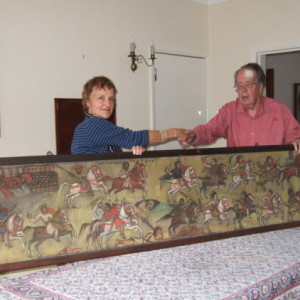Degrees of separation
My son's gift of an Emmeline Pankhurst tea towel (!) seen hanging here, has given me a way into blipping something I've been wondering how to blip, since I no longer possess the item in question. In effect, I'm blipping an absence, brought about by a curious series of coincidences, and it's a tribute too to the extraordinary power of Blip that brings together people and places in all sorts of unexpected ways.
In the space above these bookshelves there used to hang a long, narrow oil painting. It depicted a gory battle scene with warriors on horseback hacking at half-naked soldiers, against a background of mustard yellow. Since it was part of the domestic landscape as I grew up I never found it disturbing (although some did.) Within the family it was always referred to as The Abyssinian Painting. My father had collected it, as was his wont, from a London street market or junk shop in the 1930s.
In the 1960s, when my parents were more than usually strapped for cash, they thought of selling it and my father contacted a scholar of Ethiopian history, based in Addis Ababa. His reply was that the painting was of great interest but no funds were available to purchase it. The idea lapsed and the picture continued to accompany my family as we moved house. Its sixth move, with my parents long gone, brought it back to Wales and it found a place above these bookshelves where, it must be said, it was rarely noticed.
In 2006 I visited Philadelphia for the first time and had a meal at a popular Ethiopian restaurant in Baltimore Avenue. Guinea Pig Zero had already told me about its proprietor, Amare Solomon, the immigrant who started the business and become so embedded in the local community that he was known as the Pope of Baltimore Ave. His sudden death the previous year had been untimely and much lamented but his family continued to run the restaurant. Tucking into the delicious food, served on traditional injeera flat bread, I talked about about my father's Abyssinian painting and there and then resolved to return it to its homeland as a gift.
When I looked to see who had succeeded the scholar my father had contacted back in the 60s I was surprised to find that he was still in post, well into his 80s but still actively engaged upon collecting and retrieving, for a new museum in Addis Ababa, the scattered works of art that had been looted and removed from Ethiopia during the course of the 20th century. I emailed him: he remembered the correspondence with my father 40 years earlier and he said he would be delighted to accept the painting for the museum on his next visit to London where he retained a house.
Packing and dispatching the awkwardly-shaped and fragile painting (almost 7 feet long) from Wales to London proved a challenge but it arrived safely and a short time later I traveled there myself to make a formal handover to the elderly historian and his wife at their Hampstead home before their return to Addis. They were a little worried about removing the canvas from the frame to transport it but by then the problem was out of my hands.
Some time later I emailed them to inquire whether the painting had arrived safely but I had no reply. I just had to assume that it had reached its destination and was now installed in the museum. It was hardly missed from its unobtrusive place on the wall at home and I rarely gave it another thought.
Until three weeks ago! Randomly clicking on the Blip photostream I found myself looking at an image taken in the ethnographic museum in Addis Ababa by blipper Greengirl who was visiting Ethiopia. I left a comment that I had once given a painting to the museum. She asked me what it was like, I described it and the next day a picture of it was in her Blipfolio - she'd made a special trip back to the museum to find it! Looking a bit battered, with the top of the frame buckled, but there it was - the first time I'd seen it in 6 years.
So thank you Greengirl, thank you Blip and thank you reader if you've managed to persevere through this long tale of serendipity and happenstance.
And the connection with Emmeline Pankhurst, you may be wondering? Well, the scholar who has devoted his life to rescuing and promoting Ethiopian culture and history is none other than Richard Pankhurst, the son of Emmeline's daughter Sylvia and her Italian anarchist lover, Silvio Corio; Richard was born in 1927 when Sylvia was already 45 years old and he grew up in Ethiopia. Although it gave me great satisfaction to send the painting back to its people, meeting Emmeline Pankhurst's grandson was perhaps an even greater thrill.
Extra: me, Dr Pankhurst and the painting, formal handover at his house in London in 2006.
Here is blipper Greengirl's image that caught my attention and 'my' painting can be seen in the extra here, taken by Greengirl on a subsequent visit.
Here is something about Richard Pankhurst whose suffragist mother Sylvia campaigned against the Italian fascist occupation of Ethiopia during the 1930s, as a result of which her son has devoted 50 years to the country of which he is now an honorary citizen.
[Richard Pankhurst died in 2017 but his family is still actively involved in the causes he stood for.]


Comments
Sign in or get an account to comment.


